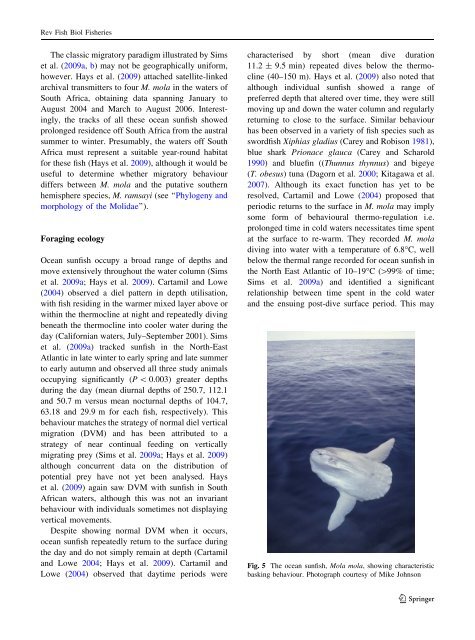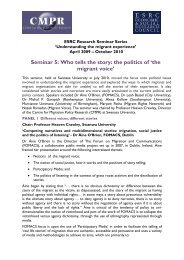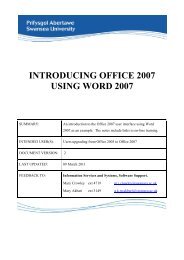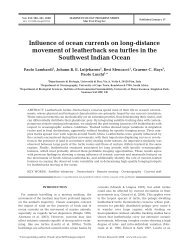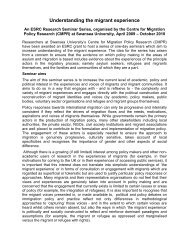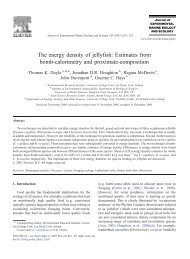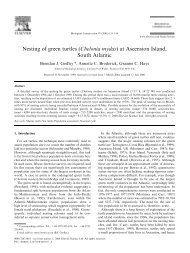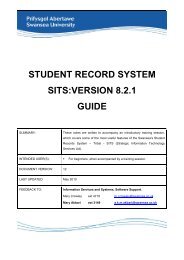The biology and ecology of the ocean sunfish - Swansea University
The biology and ecology of the ocean sunfish - Swansea University
The biology and ecology of the ocean sunfish - Swansea University
Create successful ePaper yourself
Turn your PDF publications into a flip-book with our unique Google optimized e-Paper software.
Rev Fish Biol Fisheries<br />
<strong>The</strong> classic migratory paradigm illustrated by Sims<br />
et al. (2009a, b) may not be geographically uniform,<br />
however. Hays et al. (2009) attached satellite-linked<br />
archival transmitters to four M. mola in <strong>the</strong> waters <strong>of</strong><br />
South Africa, obtaining data spanning January to<br />
August 2004 <strong>and</strong> March to August 2006. Interestingly,<br />
<strong>the</strong> tracks <strong>of</strong> all <strong>the</strong>se <strong>ocean</strong> <strong>sunfish</strong> showed<br />
prolonged residence <strong>of</strong>f South Africa from <strong>the</strong> austral<br />
summer to winter. Presumably, <strong>the</strong> waters <strong>of</strong>f South<br />
Africa must represent a suitable year-round habitat<br />
for <strong>the</strong>se fish (Hays et al. 2009), although it would be<br />
useful to determine whe<strong>the</strong>r migratory behaviour<br />
differs between M. mola <strong>and</strong> <strong>the</strong> putative sou<strong>the</strong>rn<br />
hemisphere species, M. ramsayi (see ‘‘Phylogeny <strong>and</strong><br />
morphology <strong>of</strong> <strong>the</strong> Molidae’’).<br />
Foraging <strong>ecology</strong><br />
Ocean <strong>sunfish</strong> occupy a broad range <strong>of</strong> depths <strong>and</strong><br />
move extensively throughout <strong>the</strong> water column (Sims<br />
et al. 2009a; Hays et al. 2009). Cartamil <strong>and</strong> Lowe<br />
(2004) observed a diel pattern in depth utilisation,<br />
with fish residing in <strong>the</strong> warmer mixed layer above or<br />
within <strong>the</strong> <strong>the</strong>rmocline at night <strong>and</strong> repeatedly diving<br />
beneath <strong>the</strong> <strong>the</strong>rmocline into cooler water during <strong>the</strong><br />
day (Californian waters, July–September 2001). Sims<br />
et al. (2009a) tracked <strong>sunfish</strong> in <strong>the</strong> North-East<br />
Atlantic in late winter to early spring <strong>and</strong> late summer<br />
to early autumn <strong>and</strong> observed all three study animals<br />
occupying significantly (P \ 0.003) greater depths<br />
during <strong>the</strong> day (mean diurnal depths <strong>of</strong> 250.7, 112.1<br />
<strong>and</strong> 50.7 m versus mean nocturnal depths <strong>of</strong> 104.7,<br />
63.18 <strong>and</strong> 29.9 m for each fish, respectively). This<br />
behaviour matches <strong>the</strong> strategy <strong>of</strong> normal diel vertical<br />
migration (DVM) <strong>and</strong> has been attributed to a<br />
strategy <strong>of</strong> near continual feeding on vertically<br />
migrating prey (Sims et al. 2009a; Hays et al. 2009)<br />
although concurrent data on <strong>the</strong> distribution <strong>of</strong><br />
potential prey have not yet been analysed. Hays<br />
et al. (2009) again saw DVM with <strong>sunfish</strong> in South<br />
African waters, although this was not an invariant<br />
behaviour with individuals sometimes not displaying<br />
vertical movements.<br />
Despite showing normal DVM when it occurs,<br />
<strong>ocean</strong> <strong>sunfish</strong> repeatedly return to <strong>the</strong> surface during<br />
<strong>the</strong> day <strong>and</strong> do not simply remain at depth (Cartamil<br />
<strong>and</strong> Lowe 2004; Hays et al. 2009). Cartamil <strong>and</strong><br />
Lowe (2004) observed that daytime periods were<br />
characterised by short (mean dive duration<br />
11.2 ± 9.5 min) repeated dives below <strong>the</strong> <strong>the</strong>rmocline<br />
(40–150 m). Hays et al. (2009) also noted that<br />
although individual <strong>sunfish</strong> showed a range <strong>of</strong><br />
preferred depth that altered over time, <strong>the</strong>y were still<br />
moving up <strong>and</strong> down <strong>the</strong> water column <strong>and</strong> regularly<br />
returning to close to <strong>the</strong> surface. Similar behaviour<br />
has been observed in a variety <strong>of</strong> fish species such as<br />
swordfish Xiphias gladius (Carey <strong>and</strong> Robison 1981),<br />
blue shark Prionace glauca (Carey <strong>and</strong> Scharold<br />
1990) <strong>and</strong> bluefin ((Thunnus thynnus) <strong>and</strong> bigeye<br />
(T. obesus) tuna (Dagorn et al. 2000; Kitagawa et al.<br />
2007). Although its exact function has yet to be<br />
resolved, Cartamil <strong>and</strong> Lowe (2004) proposed that<br />
periodic returns to <strong>the</strong> surface in M. mola may imply<br />
some form <strong>of</strong> behavioural <strong>the</strong>rmo-regulation i.e.<br />
prolonged time in cold waters necessitates time spent<br />
at <strong>the</strong> surface to re-warm. <strong>The</strong>y recorded M. mola<br />
diving into water with a temperature <strong>of</strong> 6.8°C, well<br />
below <strong>the</strong> <strong>the</strong>rmal range recorded for <strong>ocean</strong> <strong>sunfish</strong> in<br />
<strong>the</strong> North East Atlantic <strong>of</strong> 10–19°C ([99% <strong>of</strong> time;<br />
Sims et al. 2009a) <strong>and</strong> identified a significant<br />
relationship between time spent in <strong>the</strong> cold water<br />
<strong>and</strong> <strong>the</strong> ensuing post-dive surface period. This may<br />
Fig. 5 <strong>The</strong> <strong>ocean</strong> <strong>sunfish</strong>, Mola mola, showing characteristic<br />
basking behaviour. Photograph courtesy <strong>of</strong> Mike Johnson<br />
123


